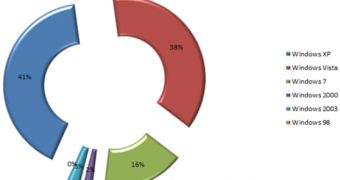Machines running Windows operating systems in most cases get infected with malware because their owners fail to update certain applications which present critical vulnerabilities that are easily exploited by malicious elements.
CSIS Security Group revealed the results of a study that went on for a period of three months, in which they've collected all sorts of data from exploit kits. It was concluded that users who fail to update applications belonging to Adobe, Java or QuickTime are the most vulnerable in front of a drive-by attack.
The purpose of their study was to determine as precisely as possible, which browsers, applications and operating systems are the most exposed and why.
To make the figures more accurate, a high number of exploit kits and computers were involved in the experiment.
Internet Explorer fans seem to represent the largest number of victims, 66% of the infections occurring on machines where the Microsoft browser was utilized the most. Mozilla Firefox is the second in line and Opera came in last. These numbers are somehow logical as there aren't as many Opera or Safari customers as there are for the winners of this category.
When it comes to operating systems, Windows XP takes the lead if they're judged by number of “exposures to malicious code,” Windows Vista following close behind with 38%. The better secured Windows 7 is third while the old 98 turned out totally clean with 0%.
In terms of programs, Adobe Reader and Java JRE battle it out for first place, with percentages around 32 and 37. Adobe's Flash Player, Internet Explorer and Windows HCP all take a piece of the pie chart.
As we've seen lately, each major software provider is constantly upgrading and updating their products because of the vulnerabilities discovered in the way they were coded. That's why it's extremely important for internauts to understand that updates are not important just when it comes to the virus definition database, but also for the applications that represent a gateway between them and the internet.

 14 DAY TRIAL //
14 DAY TRIAL //